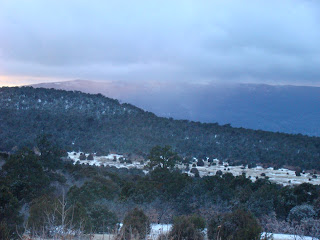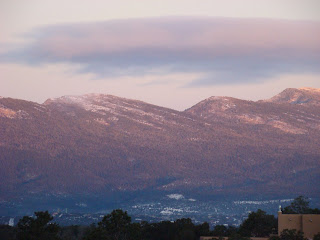 Today, after a whirlwind of planning, and not a few political and practical hitches, our women's Torah study group began.
Today, after a whirlwind of planning, and not a few political and practical hitches, our women's Torah study group began. It all started because our Sisterhood had the foresight to pre-order a large number of The Torah: A Women's Commentary about a year ago. In this way, Sisterhood was able to get a really good deal, and sell the commentaries for about half the going rate (this order only). So the Sisterhood board decided that it would be good to begin a women's Torah study group as soon as possible in order to meet the momentum of interest in this unique book at its peak. One of the members of the Sisterhood board asked me to teach the group. But in thinking about it, we decided that it would be better for me to chair the group, in order to get things started, but in the spirit of the Autonomous Learner Model, transition gradually from being a Sage on the Stage to a Guide on the Side. (Some of you will recognize this, my unschooling mantra). After all, the point is to get women to access Torah and to develop their scholarly and leadership abilities among women. And today we began.
I started by modeling a group decision making strategy that allowed us to get options for how we would study on the table, let the women discuss it, while I listened carefully. I then reported back to them what I heard to be the sense of the group: that we would meet monthly on Sunday mornings, and study the parashah (portion) of the week, the one that would be read in Synagogue the following Shabbat. That, further, we would all be paying attention to see if some themes developed that would be worth pursuing, and that we would revisit the question of theme as we continued. This was agreed to be the sense of the group, and so the group made its first decision in a women's way.
 Then I did take the Sage on the Stage role for a little bit to discuss with the women the place of Torah study in Jewish life. Torah can be translated as teaching (noun), the Hebrew root is the same for the noun 'teacher.' It is related to the root for 'light', and thus could be interpreted as 'enlightenment' as well. Our Rabbis taught that Torah is like a pomegranite--it has many seeds, many meanings. Each Jew has within herself her own seeds of Torah, that must be shared, for Torah to be whole in the world. Therefore, when the Sefer Torah (scroll) is to be read in synagogue, it is first carried through the holy congregation, to demonstrate that it belongs to the people Israel. It is not the possession of priests, prophets, kings, or rabbis. It belongs to each Jew.
Then I did take the Sage on the Stage role for a little bit to discuss with the women the place of Torah study in Jewish life. Torah can be translated as teaching (noun), the Hebrew root is the same for the noun 'teacher.' It is related to the root for 'light', and thus could be interpreted as 'enlightenment' as well. Our Rabbis taught that Torah is like a pomegranite--it has many seeds, many meanings. Each Jew has within herself her own seeds of Torah, that must be shared, for Torah to be whole in the world. Therefore, when the Sefer Torah (scroll) is to be read in synagogue, it is first carried through the holy congregation, to demonstrate that it belongs to the people Israel. It is not the possession of priests, prophets, kings, or rabbis. It belongs to each Jew.
We then discussed the basics of interpretation, using the model of PaRDeS, an acronym for understanding levels of understanding. The Hebrew word pardes, is the word for a walled garden or orchard, and is the root of the word 'paradise.' There are four levels of interpretation. The first is peshat--the simple meaning of the text, its context within Torah, and the meaning of the Hebew words. The second is remez--a hint of something more. This is the level of allegory, allusion, and connections by specific words between different texts within Torah. The third level is derash--searching for meaning. Derash lends itself to moral interepretations and midrash (homiletics) and aggadah (stories and parables). At derash, we span exegesis (thinking about the author's intentions) and isegesis (making personal or contemporary meaning). The fourth level is sod--the hidden, mystical meaning of the text. This is the level of mystical understanding in Zohar and Kabbalah, and possible in poetry and art. We also discussed here the tradition of Torah study--that it is done with a partner or group, so that personal understandings are shared and blended with the received tradition.
Then I sat down, as is customary, to study with the group a short bit of Torah from the women's commentary. For this special occasion, the beginning of the women's Torah study group, I chose two passages from parashat Nitzavi'im--'you are standing .' (Each parashah is called after the opening word or phrase).This portion is in the last book of Torah, Devarim (Deuteronomy), and is normally read in the month of Elul (August-September), as well as on Yom Kippur morning. I read the first two verses in Hebrew, and then asked one of the women to read it in English:
"You stand this day, all of you, before your G-d--you tribal heads, you elders, and you officials, all the men of Israel, you children, you women, even the stranger within your camp, from the woodchopper to the drawer of water--to enter into the covenent of you G-d...to establish you this day as G-d's people..." (Devarim 29: 9-11).
There was a gasp from one of the women. She had never heard it read exactly this way. I asked what surprised her. She said: "It sounded different. It sounded as if I was included.As if I was standing there this day."
And I explained what the translators had done. All of the different groups within the people Israel are referred to in this text with the Hebrew possessive ending -chem, which is a masculine, plural possessive. So the literal translation of the Hebrew would be "your tribal heads, your elders...your children, your women..." After pointing out the change, which is explained in the commentary, I asked the women to discuss it. How does it change our understanding of the meaning? Is it valid?
There was much discussion. "It changes the meaning." "The translator interpreted..." "All translation is interpretation." And so forth. With some guidance from me, the guide on the side, and the commentary in the text, we got to the place of discussing the meaning the possessive "your" in the context of the community of Israel. What does it mean to say "your people" or "your synagogue" or "your rabbi." Does it mean that you literally own those entities, or does it mean that you belong to them? A flash of understanding came to the women then, as one said, "So the translator was really clarifying the meaning of "your" as a belonging to, not an owning of!"
"Yes. Translation is always interpretation," I told them. But here, the translator did indeed clarify one received understanding of the text, by replacing the word "your" with the word "you." There was more discussion of how that change made some of the women realize, for the first time, that they, as women, were included in the Covenant, that they, too, were 'standing at Sinai.' So we moved from peshat to remez to derash, and perhaps, since some of us received a new understanding, a new revelation, to sod.
 And in the discussion, I heard the Torah of these women. I will never forget the words of one of them: "It is important that the translator did this, because when I hear "your tribal heads, and your elders," I think of them as men who belong to the community of Israel; but when I hear "your women," I think of the women as belonging to the men, because that is how we learned to think. But when I heard "you women," I saw myself actively accepting Torah, actively standing at Sinai."
And in the discussion, I heard the Torah of these women. I will never forget the words of one of them: "It is important that the translator did this, because when I hear "your tribal heads, and your elders," I think of them as men who belong to the community of Israel; but when I hear "your women," I think of the women as belonging to the men, because that is how we learned to think. But when I heard "you women," I saw myself actively accepting Torah, actively standing at Sinai." And I could only say: Yashrah koach! May your strength be straight! Hazak, hazak v'nit'hazek, achoti! May you go from strength to strength, oh my sister!
In this sharing, as Jewish women studying together, we brought forth Torah. We were being Torah.








































 This means that on a sunny, very cold day when there is snow on the ground, the sun hits the surface of the snow and as it reflects back, it warms the air above it. This lowers the vapor pressure at the surface of the snow, so that sublimation occurs. Sometimes, when the light is right, you can actually see the waves of water vapor coming off the snow. As sublimation occurs, the snow becomes pitted and crunchy, not from melting and refreezing, but from sublimation.
This means that on a sunny, very cold day when there is snow on the ground, the sun hits the surface of the snow and as it reflects back, it warms the air above it. This lowers the vapor pressure at the surface of the snow, so that sublimation occurs. Sometimes, when the light is right, you can actually see the waves of water vapor coming off the snow. As sublimation occurs, the snow becomes pitted and crunchy, not from melting and refreezing, but from sublimation. 





